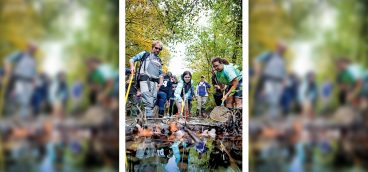Row Your Boat

You should see Pittsburgh from down here, with nothing but a shell of wood and a few threads of spandex between you and the Allegheny, the water slapping at your elbows and the skyscrapers jutting like exclamation points at the end of the river.
Pittsburgh is a city more often looked down onto, as from Mount Washington, or looked out upon, as from PNC Park. My perspective is different down here in a long, slender boat, my hands gripping an oar, sitting single file with seven other people as we row, reaching forward for every stroke that slides us over the water.
It still amazes me that I am here. Five years ago, I’d never given crew a moment’s thought. I came to it by accident. A baby sitter mentioned her high school rowing team, and I decided to try it. It was that casual, that fast and that unplanned. The next week I put on exercise clothes and drove to Washington’s Landing. I found the Three Rivers Rowing Association building and pulled into the parking lot.
I came very close to putting the car in reverse and backing out. On the grass out front were rowers — every last one of them 16 years old. I could be their mother (well, not of all of them). My adventuresome spirit brought me there, but my inner chicken was scratching a line of retreat. I could have driven away, been on Rt. 28 in two minutes and back on my front porch in 20, this brief foray to the river my own secret. I would have returned to the safe familiarity of my tennis matches and my daily run, having dipped my toe in the water, found it cold and gotten on with life.
But how sad that would have been. I would have missed some of the most exciting days of my life. I didn’t turn around and go back to my car. I slipped by the teenagers and into the building, and there I found a room full of adults, thank God — men and women in their 30s, 40s and 50s who, like me and for whatever reason, wanted to row.
I am now a member of a rowing crew sponsored by MEDRAD, Inc., the Indianola company that manufactures diagnostic medical devices. MEDRAD is one of many local corporations that participate in Three Rivers Rowing summer league. I don’t work for MEDRAD, but they needed a body. Call me a ringer. I’ll be flattered.
Three Rivers Rowing is one of those Pittsburgh gems you won’t find unless you go looking for it. The boathouse lies at the north end of what used to be known as Herr’s Island. Many local high school and college crews row from there; the Association has more than 2,300 members. Across the channel in Millvale is the other Association building with indoor training tanks, where beginners learn to row while sitting in stationary shells submerged in troughs of water. That’s where I first crouched balancing on one foot just trying to sit down. That seat slides around, making the whole effort a mean, little game of chase-the-seat-with-your-rump. Then I strap my feet into oversized shoes bolted to the boat’s floor. My size nines flop around inside the shoes. I grip the oar and take my first stroke.
And the stroke isn’t what you think it is. That person on the rowing machine at the gym, jerking his arms while sliding forward and back? Not even close.
“It’s more than just yanking on an oar,” said Devin Fay, the MEDRAD crew coach. “It’s as much as 80 percent legs, and the rest is arms and back and shoulders.”
Google crew rowing and you’ll find Web sites that describe the proper stroke. One site breaks it down into 11 parts which, if you ask me, is way too much to think about 25 times every minute. I prefer to think of the stroke in somewhat simpler terms:
Begin with the blade behind you in the water, your arms extended in front of you, knees bent against your chest. Straighten your legs while pushing back as hard and fast as you can, driving the blade through the top of water, ending the stroke with your body pivoting back and your hands holding the oar handle at your ribs. Slowly slide your rear end along the track, and do it all over again and again and again. And oh yeah, you’re sailing backwards.
“Rowing is the only time in your life you’ll be in a boat and not facing in the direction you’re traveling,” said Cindy Abbott, a beverage distributor from Mount Washington. “It’s counter intuitive.”
And almost impossible to do perfectly. Rowers compare the stroke to a golf swing, with a slow windup followed by a hard, powerful release. Done correctly, it looks easy. But don’t be fooled. My first time on the water, in a boat of beginners, we thrashed about for hours without gaining any real momentum. A tennis coach once told me that after you’ve hit a million balls, they start going where you want them to go. How many rowing strokes does it take until you get a perfect one?
“There’s something in rowing, this great feeling,” said Coach Fay. “If you get that perfect stroke in a race, you remember it for the rest of your life.”
Has he ever gotten that feeling?
“Maybe once,” he said.
Elite rowers talk about “the zone”: stringing together enough near-perfect strokes in concert with seven others in the crew and feeling the boat slide under you. It is elusive. I have not yet felt it.
“In the boat I hardly ever get that feeling,” said Marisette Edwards, a Glenshaw software engineer and MEDRAD crew captain. She has been a rower for years and, like all of us, still struggles. It has nothing to do with age. Coach Fay says the technical aspect of the rowing stroke makes mature athletes right for it.
“Aerobic capacity and technicality are more important than physical strength. As I coach, I watch the rowers start to think about the details.”
Fay says the sport, at every age level, has a way of testing limits. My first practices were intensely aerobic, and I’m in good physical condition. I can see how an inactive person could be scared away. At top speed, elite rowers do as many as 35 strokes per minute. In races, MEDRAD reaches stroke rates of 28, and I work as hard as ever. Watch a top university men’s team and you will see eight Baryshnikovs with pistons in their hands, working in brilliant unison. Their boat does not “check” each time the oars hit the water as my boat does. Their momentum is seamless.
I’m afraid I started too late to ever experience anything like that, but my children will have the chance. Have a tall, athletic daughter? Get her started in crew. According to RowersAlmanac.com, 62 universities (including Duquesne and West Virginia) now offer full scholarships to women rowers, compared to just 26 for men. Why the disparity? Fielding a women’s rowing team is a smart way for colleges to meet Title IX federal requirements to balance spending on men’s and women’s sports.
The Pittsburgh rowing season is long, from April until November. If you cross the 16th Street Bridge early most mornings, you’ll see the master’s teams rowing through the mist.
“You can’t explain it to people,” said Linda Lang, an office receptionist from Millvale who is a member of Three Rivers Rowing’s master’s crew. She is also the coxswain of the MEDRAD crew, barking commands and steering the boat. “In the morning, the temperatures are cooler. You go out that back channel, and the steam is coming off the water. It is just unbelievable, and you think, ‘Oh my God, I wish everyone could see this.’”
The back channel is the slender bit of river between the island and the mainland. Boats are launched there in a drill that is probably every oarsman’s least favorite part of rowing. A boat is 60 feet long and 240 pounds, and, even with eight people carrying, it’s heavy.
But once it’s in the channel and you’re pushing off the dock, adrenalin takes over. “It’s got to be one of the best places in the country to row,” said Cindy Abbott. “You’re up in the back channel, and you feel like you’re in the Canadian wilderness. Then you get out on the river, and there’s downtown and all the bridges, and it’s so cool.”
There are moments so dazzling, so wrapped in joy and panic that they stay with you. My moment came last October in Pittsburgh’s Head of the Ohio Race, a punishing 5,000-meter marathon and annual mecca for crews from all over the world.
I was nervous as our crew paddled upstream to the starting line. We would race for over three miles, at speeds faster than we’d ever reached. There was a little voice that asked whether this would be the time I’d push my heart one beat too far, giving it a reason to up and quit.
We sat in the chute, waiting for the start. “Your heart pounding?” I asked the rower in front of me. She turned over her shoulder and said, “Yeah, yours?”
Something about that anticipation and terror reminded me of the first time I’d had that feeling. I was 20 and just starting my career as a journalist. I was a girl from a Mon Valley town who had stepped off a streetcar in downtown Pittsburgh for an internship at a radio station.
In the big picture I was just a pixel. But I was part of something important and impressive.
Just before the starting horn sounded, I looked over my shoulder and saw that same city. I was going to conquer it again, but this time by river. I looked up to my right at the traffic on Rt. 28, and thought about that day three years ago, when I almost hopped back onto the highway and pretended I’d never thought about rowing. To think I came close to missing all this: my heart pounding, faster crews skimming past us, the sunlight spilling in our wake like syrup from a bottle.
“Sit ready to row!” shouted our coxswain. “And Row!”
And we were off. Me, a cog among my crewmates. Faces of competitors left and right. Arms to oars churning the Allegheny. And me, me of all people, pulling hard in the middle, aiming for the city and chasing that one perfect stroke.





